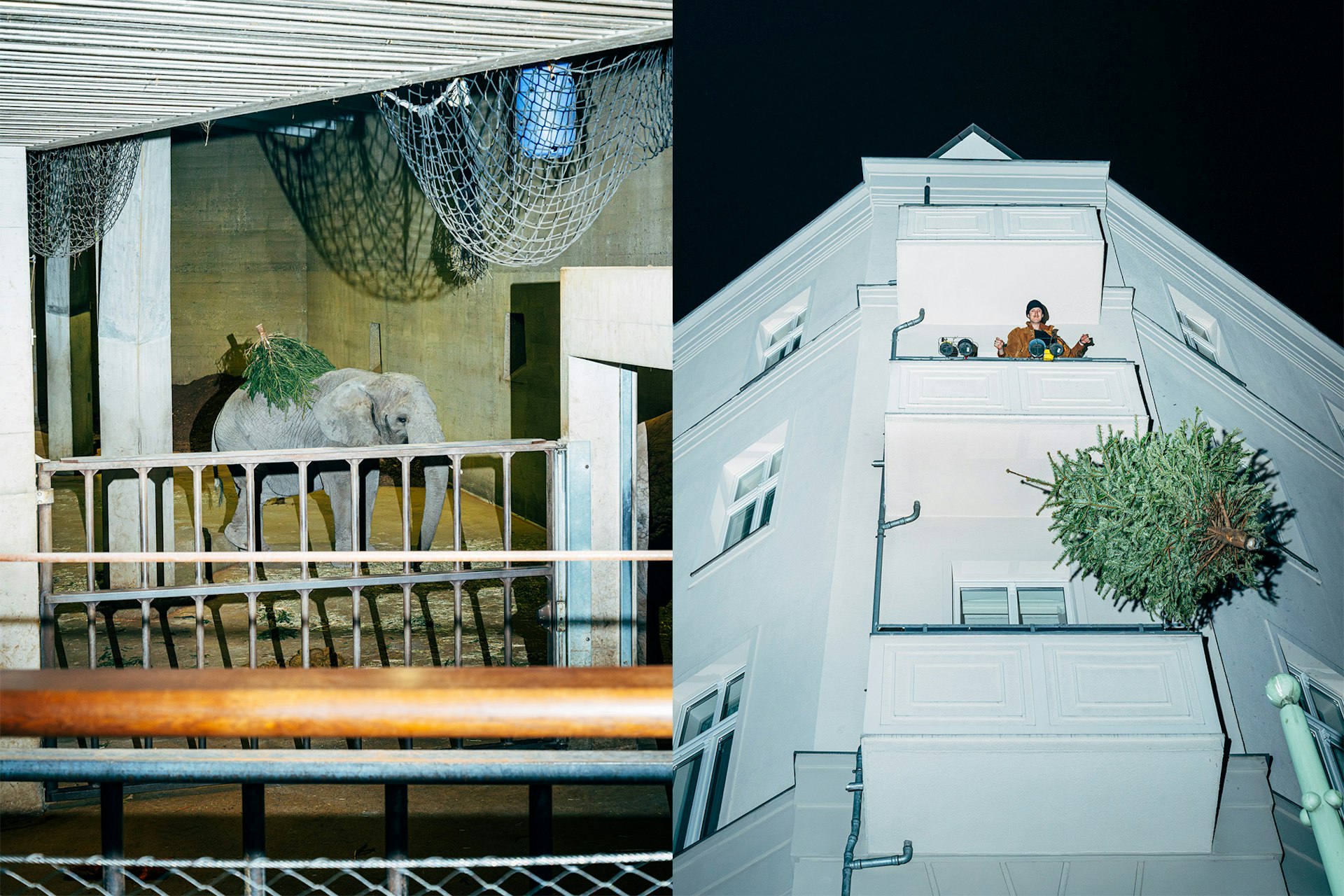Inside the lurid, laugh-out-loud world of Alex Gamsu Jenkins
- Text by Niall Flynn
- Photography by Theo McInnes
- Illustrations by Alex Jenkins

To discover the drawings of Alex Gamsu Jenkins is to trip, fall and tumble into a garish world of strange, knocking your head a few times on the way down. Crafted with horror and humour in equal shares, the 29-year-old illustrator depicts scenes plucked from the freakiest depths of the modern id.

For instance: in one, a sentient treadmill cackles as it swallows its panting user. In another, a grotesque slug creature patiently observes a wellness tutorial on YouTube. Elsewhere, a kid jams a joint into his nostril and inhales, only for a gang of floating mouths to appear – grinning – and whisper nasties behind him. And they’re some of the more conventional ones.
Through his work, Alex (who added ‘Gamsu’, his mother’s maiden name, to his title after discovering another illustrator operating as Alex Jenkins) has become a narrator for the collective anxieties experienced by millennials in the world today. His characters drink, smoke and sweat their way through life, slaves to both their devices and unshakable self-loathing.
“When it comes to the process of trying to think of ideas, what’s going to spark in your brain is going to be things that you’ve probably experienced yourself,” he says, smiling. “It’s not like my work is a direct portrait of me, but I think it’s always something I have experienced. Otherwise, how would I think of it?”
“I was fairly quiet, maybe a little bit lost. I think most teenagers are lost. And a little bit insecure.”
Hunched in the corner of a cosy pub just off Hackney’s Broadway Market in London, Alex doesn’t quite fit the stereotypical profile of the tortured artist. He’s warm, well-dressed and built like an NFL quarterback. However, there is something in his voice that hints at the apprehension that is often seen in his work.
Growing up in an artistic family in Penge, south-east London, Alex was encouraged to draw from an early age. But after reaching secondary school, his enthusiasm fell away. “I went to a school which wasn’t very encouraging, artistically,” he explains. “It was probably like anywhere in suburban London, but it was a little bit rough – one of the worst ones in the borough. I moved away from drawing completely for, like, 10 years.”
Though his interest never faded, he did stop taking it seriously. In the “macho world” that was the all-boys school he attended, being arty was – in so many words – discouraged. “I was a bit introverted. I always remember, you know, trying to fit in with everyone who was around me,” he continues. “So I was fairly quiet, maybe a little bit lost. I think most teenagers are lost. And a little bit insecure.”
However, years later, things began to swing back when his uncle – a keen sketcher himself – bought him a book on Robert Crumb, the controversial American cartoonist and prominent figure in the underground comix movement of the late ’60s and ’70s. Older now, Alex was immediately transfixed by the work. “He did these drawings that were layered, rude, grotesque – like they were on acid. I was like, ‘Whoa, this is amazing, ‘I want to try and do that.’”
So, aged 22, he enrolled in an illustration BA at Camberwell College of Arts. There, he began immersing himself in the world that had captivated him as a kid. Slightly older than the cohort of classmates who’d joined straight out of college, while younger than the mature students, Alex existed somewhat separately to the rest of the course: in his own world, if you like.
“Looking back, I think it really helped in a way, because it made me a lot more studious. I’d worked in a Sainsbury’s for four years, scratching my belly button. If I had not done that, and gone through that, and been a bit lost and bored and underachieving, things might have been different.”
Left to his own devices, he was able to dedicate himself wholly to developing the style that he’s synonymous with today – one he happily describes as “comic grotesque” – as well as the aforementioned Crumb, he cites influences that range from Francisco Goya (the Spanish painter of the late 18th and early 19th century) to Dragon Ball Z (the anime series).
During his final year, he met with an illustrator who’d graduated from the same course years before to conduct a short interview as part of his dissertation project. While they were talking, Alex asked him if he any advice on what to do once he too was finished at Camberwell. The response was simple: ‘Don’t hide away, get yourself out there, start emailing.’ But for the young artist, that kind of confidence wasn’t something that came all that naturally.
“It’s not like my work is a direct portrait of me, but I think it’s always something I have experienced. Otherwise, how would I think of it?”
“I used to be really awkward about showing my stuff to people,” he admits. “I mean, even now I am. But I used to get really sweaty and nervous. If I had to present something that I’d done, I’d just get it out of the way and then walk away.”
But, upon graduating, he did as he was advised and began putting himself out there. Eventually, it led to jobs for the likes of Time Out and Vice, which exposed his work to larger audiences for the first time. Meanwhile, his Instagram account became an ever-updating archive of lurid, laugh-out-loud scenes, detailing the collective unease of young people all over the world.
“It’s not something I really think about beforehand, or I discuss with people, but usually an idea will pop up, and then people will be like, ‘Oh, yeah, I can relate to that. It’s more unconscious.”
Fast-forward to the present day, and Alex has amassed a global fanbase. He’s designed clothing, illustrated comics and secured commissions for The New York Times, Adult Swim and Vans (to name just a few). The world that he created for himself – first as a small child, then as a student who felt that, perhaps, he didn’t fit in – has opened itself to the rest of us, brassy technicolour and all.
For the Londoner, though, it’s just a case of doing what he’s always been good at. Through drawing, Alex Gamsu Jenkins has found a voice that may have otherwise eluded him, delivering messages that resonate on the vastest of scales. It’s funny, weird, gross, profound, comforting and deranged. And completely his own.
“I’ve always felt like I’m really bad at delivering jokes, telling stories. It’s a skill that I’ve always been like, ‘I wish I could have that verbally.’ When you know someone who can do that really well, everyone’s drawn to them,” he says, before pausing momentarily to gather his thoughts. “I never associated myself with storytelling before. But now with the comics and everything... yeah, it’s enjoyable.”
This story was originally published in 2019.
Read more stories from This Is Off The Wall, an editorial partnership from Huck and Vans.
Latest on Huck

Los Angeles is burning: Rick Castro on fleeing his home once again
Braver New World — In 2020, the photographer fled the Bobcat Fire in San Bernardino to his East Hollywood home, sparking the inspiration for an unsettling photo series. Now, while preparing for its exhibition, he has had to leave once again, returning to the mountains.
Written by: Miss Rosen

Ghais Guevara: “Rap is a pinnacle of our culture”
What Made Me — In our new series, we ask artists and rebels about the forces and experiences that have shaped who they are. First up, Philadelphian rap experimentalist Ghais Guevara.
Written by: Ghais Guevara

Gaza Biennale comes to London in ICA protest
Art and action — The global project, which presents the work of over 60 Palestinian artists, will be on view outside the art institution in protest of an exhibition funded by Bloomberg Philanthropies.
Written by: Cyna Mirzai

Ragnar Axelsson’s thawing vision of Arctic life
At the Edge of the World — For over four decades, the Icelandic photographer has been journeying to the tip of the earth and documenting its communities. A new exhibition dives into his archive.
Written by: Cyna Mirzai

ATMs & lion dens: What happens to Christmas trees after the holiday season?
O Tannenbaum — Nikita Teryoshin’s new photobook explores the surreal places that the festive centrepieces find themselves in around Berlin, while winking to the absurdity of capitalism.
Written by: Isaac Muk

Resale tickets in UK to face price cap in touting crackdown
The move, announced today by the British government, will apply across sport, music and the wider live events industry.
Written by: Isaac Muk








